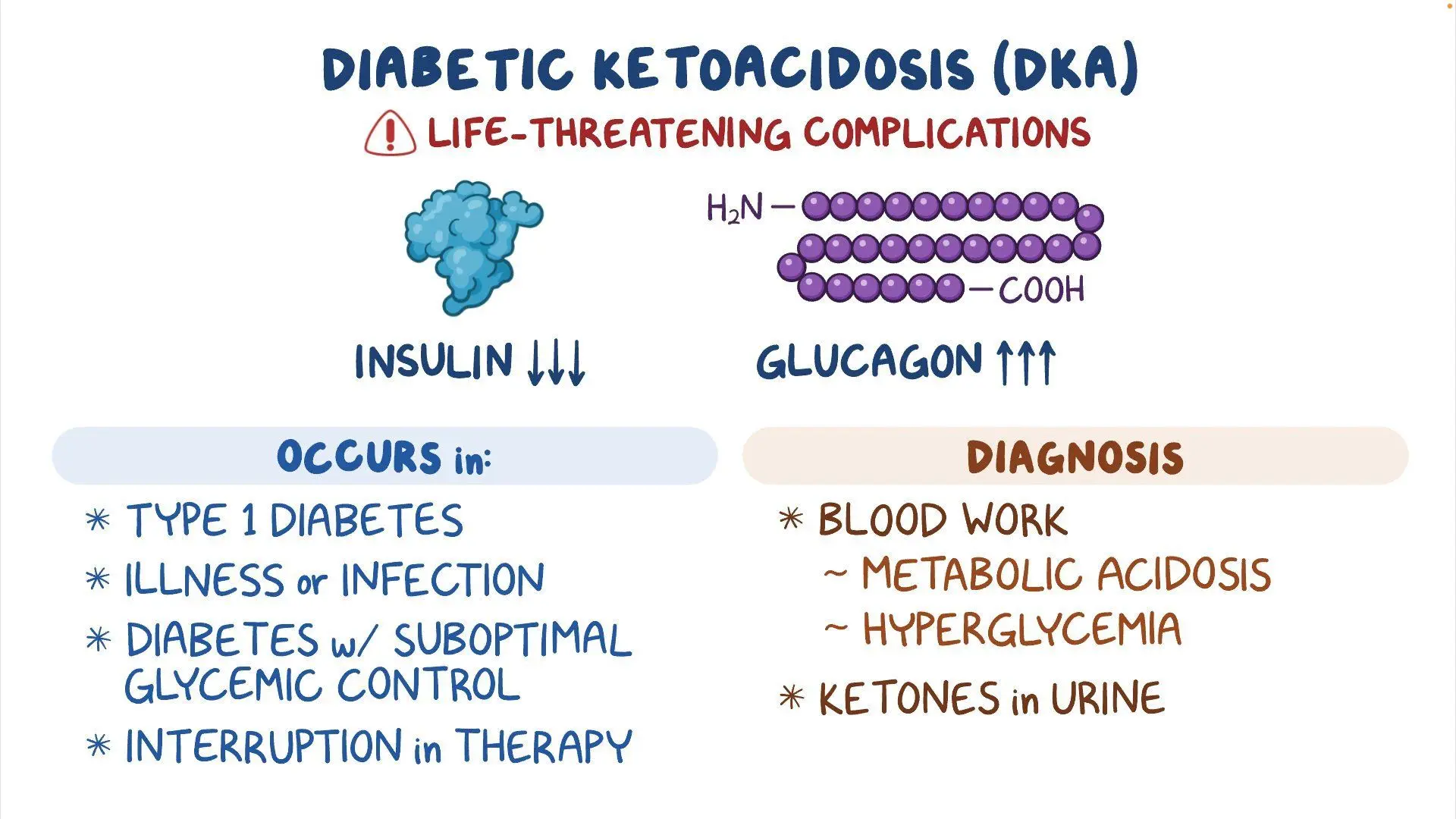How Long Does It Take to Die From Diabetic Ketoacidosis?
Diabetic ketoacidosis (DKA) is a severe, life-threatening complication of diabetes. It occurs when the body doesn’t have enough insulin to process glucose for energy, leading to the production of toxic ketones. Without timely intervention, DKA can lead to coma or even death. But how fast can it become fatal? To answer this, let’s explore what causes DKA, its symptoms, progression, treatment, and prevention strategies.
Table of Contents
Introduction to Diabetic Ketoacidosis (DKA)
DKA develops when insulin levels are insufficient, causing the body to break down fat for energy. This process releases ketones—a type of acid—into the bloodstream. As ketone levels rise, the blood becomes dangerously acidic, leading to a condition known as diabetic ketoacidosis. While DKA is most commonly associated with Type 1 diabetes, it can also occur in some people with advanced Type 2 diabetes.
The purpose of this blog is to help you understand how DKA unfolds and what you can do to recognize and manage it before it becomes life-threatening.
What Causes DKA?
The primary trigger for DKA is a lack of insulin in the body. Insulin is the hormone responsible for regulating blood sugar levels and delivering glucose to cells for energy. When insulin is insufficient, glucose stays in the bloodstream, and the body turns to fat as an alternate energy source.
Common Triggers of DKA:
- issed insulin doses or inadequate insulin levels
- Undiagnosed diabetes (especially Type 1 diabetes)
- Illness or infection (e.g., pneumonia, urinary tract infections)
- Severe physical or emotional stress
- Alcohol or drug abuse, especially with cocaine
- Certain medications, like corticosteroids or SGLT2 inhibitors
- Dehydration, which worsens glucose concentration and ketone accumulation
- It’s essential to identify these causes early to minimize the risks of ketoacidosis.
- Symptoms and Warning Signs
Recognizing the symptoms of DKA can help you act quickly. Symptoms typically escalate, starting mild and potentially becoming severe within just a few hours.
- Early Symptoms:
- Frequent urination
- Extreme thirst
- Nausea or vomiting
- Headaches
- Dry mouth
- Advanced Symptoms:
- Fruity-smelling breath (from ketones)
- Rapid, deep breathing (Kussmaul breathing)
- Abdominal pain
- Weakness or fatigue
- Confusion or disorientation
- Decreased alertness or unconsciousness
If you notice any of these symptoms, especially in combination, it’s critical to seek medical attention immediately.
How Quickly Can DKA Become Life-Threatening?
The speed at which DKA becomes fatal varies significantly depending on individual circumstances. Generally, untreated DKA can lead to severe complications or death in as little as 24 hours. This timeline may accelerate in vulnerable populations, such as children, elderly individuals, or those with preexisting health conditions.
Factors like dehydration, the severity of insulin deficiency, and additional health complications like infection can shorten this timeline even further.
Key takeaway? DKA is a medical emergency. Timely intervention can significantly reduce the risk of fatal outcomes.
Factors That Influence the Timeline of DKA Progression
Several factors affect how quickly DKA progresses:
1. Health Condition at Onset
People with existing health conditions, especially infections, are at higher risk of rapid DKA deterioration.
2. Type of Diabetes
DKA is more common and severe in Type 1 diabetes, as the body produces little to no insulin. However, it can occur in Type 2 diabetes under prolonged stress or illness.
3. Age
Younger individuals (children or teens) may experience a faster onset of symptoms due to higher metabolic rates. Elderly patients are also at risk, often due to delayed symptom recognition.
4. Access to Treatment
Proper access to insulin and rapid treatment can halt the progression of DKA. Delayed diagnosis or treatment allows DKA to worsen progressively.
5. Underlying Triggers
Specific triggers such as severe infections, substance use, or missed insulin doses can accelerate DKA development.
By addressing these factors, DKA’s deadly progression can often be mitigated.
Treatment Options for DKA
DKA treatment aims to stabilize glucose levels, reverse acidosis, and rehydrate the body. Treatment is usually carried out in a hospital setting due to the potential severity of the condition.
Intravenous Insulin
Insulin is administered via IV to lower blood glucose levels and stop further ketone production.
Fluid Replacement
To combat dehydration, IV fluids are used to rehydrate the body and restore proper electrolyte balance.
Electrolyte Management
Replenishment of potassium, sodium, and other depleted electrolytes is critical to prevent complications like cardiac arrhythmias.
Treating Underlying Causes
If an infection or other health event triggers the DKA, that issue must be addressed alongside the primary treatment.
Preventing DKA: Tips for Diabetics
While DKA can be life-threatening, it is often preventable with proper diabetes management and awareness.
Recommendations:
Take insulin as prescribed. Never skip doses, even when feeling unwell.
Monitor your blood sugar regularly. Keeping levels in range can prevent severe complications.
Test for ketones during illness. Use urine or blood test strips to check ketone levels if your blood sugar exceeds 300 mg/dL.
Stay hydrated. Drink water consistently, especially when ill or dehydrated.
Follow a diabetes management plan. Work closely with a healthcare provider for routine checkups, medication advice, and diet recommendations.
Small, consistent steps toward managing diabetes can significantly reduce your risk of DKA.
Complications of Untreated DKA
Without treatment, DKA can lead to numerous severe complications, including:
Cerebral edema (brain swelling) Can occur in severe or prolonged cases.
Kidney damage: Resulting from severe dehydration and electrolyte imbalances.
- Coma: Caused by dangerously high blood sugar and acid levels disrupting brain function.
- Cardiac arrest: Due to severe imbalances in electrolytes, particularly potassium, which can cause the heart to stop.
- Multi-organ failure: When vital organs like the heart, kidneys, and liver cannot function properly because of metabolic stress.
These complications can happen fast. That’s why untreated DKA is considered a medical emergency and why urgent treatment is essential.
When to Seek Emergency Help
Time is critical with DKA. If you or someone with diabetes experiences the following, seek urgent medical care:
- Persistent vomiting or inability to keep fluids down
- Severe abdominal pain
- Rapid, deep breathing or trouble catching your breath
- Confusion, drowsiness, or loss of consciousness
- Blood sugar consistently above 300 mg/dL, and the presence of moderate to high ketones
Don’t wait for symptoms to get worse. Immediate action can save a life.
Living With Diabetes: Managing Risks
Managing diabetes is a journey, but it’s absolutely possible to live a whole and active life. Here are some ways to keep DKA risk low:
- Keep up with daily medications and insulin schedules.
- Stay alert to physical changes or unusual symptoms.
- Have a sick day plan: Know how to adjust insulin, fluids, and food if you become ill.
- Share your plan: Make sure family and close friends know the signs of DKA and what to do.
- Schedule regular checkups: Work with your healthcare team, keep appointments and update your care plan as needed.
- Learn about DKA symptoms and triggers so you feel confident recognizing early warnings.
A little preparation and awareness can make a big difference in preventing emergencies.
Frequently Asked Questions (FAQs)
Can DKA happen to people with Type 2 diabetes?
Yes, while it’s more common in people with Type 1 diabetes, those with Type 2—especially during periods of illness, dehydration, or severe stress—can develop DKA. This is especially true for those whose bodies have stopped producing enough insulin.
How can I test for ketones at home?
Urine ketone strips and blood ketone meters are available in most pharmacies. Testing for ketones is important if your blood sugar is over 300 mg/dL or you experience vomiting, especially during illness.
What should I do if I suspect DKA?
Don’t try to manage it at home. Call your healthcare provider or go to the emergency room right away. Immediate treatment is the safest choice.
Are children and teens at higher risk for DKA?
Yes, DKA can develop quickly in children and teens, often as the first sign of undiagnosed diabetes. That’s why any combination of symptoms like extreme thirst, rapid breathing, and abdominal pain in a young person should prompt urgent evaluation.
What causes DKA to develop so fast in some cases?
Missing insulin doses, sudden illness, or infections can all cause DKA to accelerate. Dehydration and certain medications can also make DKA move from mild to severe in a matter of hours.
How long does it take to recover from DKA after treatment?
With prompt treatment, most people begin to improve within 24 hours, though full recovery and normalization of lab values may take a few days. Early care makes for a smoother, safer recovery.
How do I prevent DKA during illness or travel?
Monitor your blood sugar and ketone levels more frequently. Drink plenty of fluids, continue taking insulin as advised, and contact your healthcare provider for instructions.
Is DKA preventable?
In most cases, yes. Sticking to your diabetes management plan, recognizing early warning signs, and catching problems early make a huge difference.
What if I can’t afford insulin or testing supplies?
Reach out to your diabetes care provider or local health organizations. There are assistance programs and resources to help with access to vital medication and supplies.
Final Thoughts
Diabetic ketoacidosis can be terrifying, but knowledge is power. Recognizing symptoms early, having a clear plan for emergencies, and staying engaged in your diabetes care are all key steps to staying safe. With careful management and immediate action when needed, you can take charge of your health and reduce the risk of DKA becoming life-threatening.
If you live with diabetes, never hesitate to ask questions or seek extra support. Your awareness and quick response could mean the difference between discomfort and a full recovery.
Stay informed, communicate with your healthcare team, and pay attention to your body—these steps help keep DKA at bay and support a healthier future.







